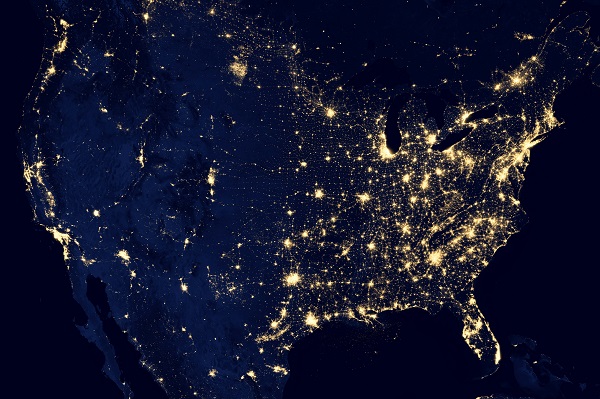Energy
Trump vows to reduce energy costs with his latest cabinet picks

From The Center Square
By Casey Harper
“With U.S. Energy Dominance, we will drive down Inflation, win the A.l. arms race with China (and others), and expand American Diplomatic Power to end Wars all across the World.”
With his latest cabinet nominations, President-elect Donald Trump promised to bring down the cost Americans pay for energy by expanding oil and gas production.
Trump named North Dakota Gov. Doug Burgum as secretary of the Interior as well as chairman of “the newly formed, and very important, National Energy Council.”
“As Chairman of the National Energy Council, Doug will have a seat on the National Security Council,” Trump said in a statement. “As Secretary of the Interior, Doug will be a key leader in ushering in a new ‘Golden Age of American Prosperity’ and World Peace. ‘
“We will ’DRILL BABY DRILL,’ expand ALL forms of Energy production to grow our Economy, and create good-paying jobs,” he added. “By smartly utilizing our amazing National Assets, we will preserve and protect our most beautiful places, AND reduce our deficits and our debt!”
Trump said the new energy council will involve all parts of the federal government dealing with energy.
“This Council will oversee the path to U.S. ENERGY DOMINANCE by cutting red tape, enhancing private sector investments across all sectors of the Economy, and by focusing on INNOVATION over longstanding, but totally unnecessary, regulation,” Trump said. “With U.S. Energy Dominance, we will drive down Inflation, win the A.l. arms race with China (and others), and expand American Diplomatic Power to end Wars all across the World.”
As part of his Burgum pick and his nomination of fracking entrepreneur Chris Wright to lead the Department of Energy, Trump promised to get energy prices down.
“We will also undo the damage done by the Democrats to our Nation’s Electrical Grid, by dramatically increasing baseload power,” Trump said.
Trump also named William Owen Scharf as assistant to the President and White House Staff Secretary.
So far, Trump has pointed to the loyalty of his choices, saying how they endorsed him or helped him win reelection when announcing them as his choices.
“Will is a highly skilled attorney who will be a crucial part of my White House team. He has played a key role in defeating the Election Interference and Lawfare waged against me, including by winning the Historic Immunity Decision in the Supreme Court.”
Trump followed his electoral win with a flurry of cabinet picks, some expected and some that are sure to stir things up.
In particular, Trump’s picks of Robert F Kennedy Jr to lead the Department of Health and Human services, veteran and Fox News host Pete Hegseth to lead the Secretary of Defense, and former Congressman Matt Gaetz to lead the Department of Justice have sparked headlines.
More picks are on the way as Trump has to fill out positions across the federal government.
Whether Trump can get the Senate to confirm his nominees, especially the more controversial picks, remains to be seen.
Trump’s list of nominees so far include:
- North Dakota Gov. Doug Burgum as Secretary of the Interior.
- William Owen Scharf as Assistant to the President and White House Staff Secretary.
- Robert F. Kennedy Jr. as head of U.S. Health and Human Services
- Former Congresswoman and veteran Tulsi Gabbard as Director of National Intelligence.
- Former Congressman Doug Collins as Secretary of Veterans Affairs
- Jay Clayton as Chairman of the U.S. Securities and Exchange Commission.
- Former congressman Matt Gaetz for Attorney General.
- Veteran and Fox News host Pete Hegseth as Secretary of Defense.
- Veteran and former New York congressman Lee Zeldin as head of the Environmental Protection Agency.
- U.S. Sen. Marco Rubio, R-Fla., as Secretary of State.
- Former Immigration and Customs Enforcement Director Tom Homan as “border czar.”
- Former Director of National Intelligence John Ratcliffe as Director of the Central Intelligence Agency.
- Former Congresswoman and current governor of South Dakota, Kristi Noem as Secretary of the Department of Homeland Security.
- Elon Musk and Vivek Ramaswamy to lead the “Department of Government Efficiency.
- William Joseph McGinley as White House Counsel.
- Steven C. Witkoff as Special Envoy to the Middle East.
- Rep. Mike Waltz, R-Fla. as national security advisor.
- Former Arkansas Gov. Mike Huckabee as ambassador to Israel.
- Rep. Elise Stefanik, R-N.Y. as ambassador to the U.N.
- Dean John Sauer as Solicitor General.
- Todd Blanche as Deputy Attorney General.
- Emil Bove as Principal Associate Deputy Attorney General.
- Dan Scavino of the Trump campaign as Assistant to the President and Deputy Chief of Staff.
- Susie Wiles, co-chair of the Trump campaign, as White House Chief of Staff.
- Stephen Miller as Assistant to the President and Deputy Chief of Staff for Policy and Homeland Security Advisor.
- James Blair of the Trump campaign as Assistant to the President and Deputy Chief of Staff for Legislative, Political and Public Affairs.
- Taylor Budowich of the Trump campaign as Assistant to the President and Deputy Chief of Staff for Communications and Personnel.
Casey Harper
D.C. Bureau Reporter
Daily Caller
Blackouts Coming If America Continues With Biden-Era Green Frenzy, Trump Admin Warns


From the Daily Caller News Foundation
By Audrey Streb
The Department of Energy (DOE) released a new report Monday warning of impending blackouts if the United States continues to shutter power plants without adequately replacing retiring capacity.
DOE warned in its Monday report that blackouts could increase by 100% by 2030 if the U.S. continues to retire power plants without sufficient replacements, and that the electricity grid is not prepared to meet the demand of power-hungry data centers in the years to come without more reliable generation coming online quickly. The report specifically highlighted wind and solar, two resources pushed by Biden, as responsible for eroding grid stability and advised that dispatchable generation from sources like coal, oil, gas and nuclear are necessary to meet the anticipated U.S. power demand.
“This report affirms what we already know: The United States cannot afford to continue down the unstable and dangerous path of energy subtraction previous leaders pursued, forcing the closure of baseload power sources like coal and natural gas,” DOE Secretary Chris Wright said. “In the coming years, America’s reindustrialization and the AI race will require a significantly larger supply of around-the-clock, reliable, and uninterrupted power. President Trump’s administration is committed to advancing a strategy of energy addition, and supporting all forms of energy that are affordable, reliable, and secure. If we are going to keep the lights on, win the AI race, and keep electricity prices from skyrocketing, the United States must unleash American energy.”
Dear Readers:
As a nonprofit, we are dependent on the generosity of our readers.
Please consider making a small donation of any amount here.
Thank you!
All regional grid systems across the U.S. are expected to lose reliability in the coming years without the addition of more reliable power, according to the DOE’s report. The U.S. will need an additional 100 gigawatts of new peak hour supply by 2030, with data centers projected to require as much as half of this electricity, the report estimates; for reference, one gigawatt is enough to power up to one million homes.
President Donald Trump declared a national energy emergency on his first day back in the Oval Office and signed an executive order on April 8 ordering DOE to review and identify at-risk regions of the electrical grid, which the report released Monday does. In contrast, former President Joe Biden cracked down on conventional power sources like coal with stringent regulations while unleashing a gusher of subsidies for green energy developments.
Electricity demand is projected to hit a record high in the next several years, surging 25% by 2030, according to Energy Information Administration (EIA) data and a recent ICF International report. Demand was essentially static for the last several years, and skyrocketing U.S. power demand presents an “urgent need” for electricity resources, according to the North American Electric Reliability Corporation (NERC), a major grid watchdog.
Wright has also issued several emergency orders to major grid operators since April. New Orleans experienced blackouts just two days after Wright issued an emergency order on May 23 to the Midcontinent Independent System Operator (MISO), the regional grid operator covering the New Orleans area.
Alberta
COWBOY UP! Pierre Poilievre Promises to Fight for Oil and Gas, a Stronger Military and the Interests of Western Canada

Fr0m Energy Now
As Calgarians take a break from the incessant news of tariff threat deadlines and global economic challenges to celebrate the annual Stampede, Conservative party leader Pierre Poilievre gave them even more to celebrate.
Poilievre returned to Calgary, his hometown, to outline his plan to amplify the legitimate demands of Western Canada and not only fight for oil and gas, but also fight for the interests of farmers, for low taxes, for decentralization, a stronger military and a smaller federal government.
Speaking at the annual Conservative party BBQ at Heritage Park in Calgary (a place Poilievre often visited on school trips growing up), he was reminded of the challenges his family experienced during the years when Trudeau senior was Prime Minister and the disastrous effect of his economic policies.
“I was born in ’79,” Poilievre said. “and only a few years later, Pierre Elliott Trudeau would attack our province with the National Energy Program. There are still a few that remember it. At the same time, he hammered the entire country with money printing deficits that gave us the worst inflation and interest rates in our history. Our family actually lost our home, and we had to scrimp and save and get help from extended family in order to get our little place in Shaughnessy, which my mother still lives in.”
This very personal story resonated with many in the crowd who are now experiencing an affordability crisis that leaves families struggling and young adults unable to afford their first house or condo. Poilievre said that the experience was a powerful motivator for his entry into politics. He wasted no time in proposing a solution – build alliances with other provinces with mutual interests, and he emphasized the importance of advocating for provincial needs.
“Let’s build an alliance with British Columbians who want to ship liquefied natural gas out of the Pacific Coast to Asia, and with Saskatchewanians, Newfoundlanders and Labradorians who want to develop their oil and gas and aren’t interested in having anyone in Ottawa cap how much they can produce. Let’s build alliances with Manitobans who want to ship oil in the port of Churchill… with Quebec and other provinces that want to decentralize our country and get Ottawa out of our business so that provinces and people can make their own decisions.”
Poilievre heavily criticized the federal government’s spending and policies of the last decade, including the increase in government costs, and he highlighted the negative impact of those policies on economic stability and warned of the dangers of high inflation and debt. He advocated strongly for a free-market economy, advocating for less government intervention, where businesses compete to impress customers rather than impress politicians. He also addressed the decade-long practice of blocking and then subsidizing certain industries. Poilievre referred to a famous quote from Ronald Reagan as the modus operandi of the current federal regime.
“The Government’s view of the economy could be summed up in a few short phrases. If anything moves, tax it. If it keeps moving, regulate it. And if it stops moving, subsidize it.”
The practice of blocking and then subsidizing is merely a ploy to grab power, according to Poilievre, making industry far too reliant on government control.
“By blocking you from doing something and then making you ask the government to help you do it, it makes you reliant. It puts them at the center of all power, and that is their mission…a full government takeover of our economy. There’s a core difference between an economy controlled by the government and one controlled by the free market. Businesses have to clamour to please politicians and bureaucrats. In a free market (which we favour), businesses clamour to impress customers. The idea is to put people in charge of their economic lives by letting them have free exchange of work for wages, product for payment and investment for interest.”
Poilievre also said he plans to oppose any ban on gas-powered vehicles, saying, “You should be in the driver’s seat and have the freedom to decide.” This is in reference to the Trudeau-era plan to ban the sale of gas-powered cars by 2035, which the Carney government has said they have no intention to change, even though automakers are indicating that the targets cannot be met. He also intends to oppose the Industrial Carbon tax, Bill C-69 the Impact Assessment Act, Bill C-48 the Oil tanker ban, the proposed emissions cap which will cap energy production, as well as the single-use plastics ban and Bill C-11, also known as the Online Streaming Act and the proposed “Online Harms Act,” also known as Bill C-63. Poilievre closed with rallying thoughts that had a distinctive Western flavour.
“Fighting for these values is never easy. Change, as we’ve seen, is not easy. Nothing worth doing is easy… Making Alberta was hard. Making Canada, the country we love, was even harder. But we don’t back down, and we don’t run away. When things get hard, we dust ourselves off, we get back in the saddle, and we gallop forward to the fight.”
Cowboy up, Mr. Poilievre.
Maureen McCall is an energy professional who writes on issues affecting the energy industry.
-

 Alberta2 days ago
Alberta2 days agoAlberta Provincial Police – New chief of Independent Agency Police Service
-

 International2 days ago
International2 days agoCBS settles with Trump over doctored 60 Minutes Harris interview
-

 Business2 days ago
Business2 days agoWhy it’s time to repeal the oil tanker ban on B.C.’s north coast
-

 Energy2 days ago
Energy2 days agoIf Canada Wants to be the World’s Energy Partner, We Need to Act Like It
-

 Alberta2 days ago
Alberta2 days agoPierre Poilievre – Per Capita, Hardisty, Alberta Is the Most Important Little Town In Canada
-

 Aristotle Foundation2 days ago
Aristotle Foundation2 days agoHow Vimy Ridge Shaped Canada
-

 Alberta1 day ago
Alberta1 day agoAlberta uncorks new rules for liquor and cannabis
-

 Canadian Energy Centre2 days ago
Canadian Energy Centre2 days agoAlberta oil sands legacy tailings down 40 per cent since 2015





